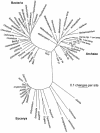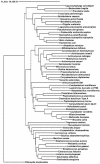Impact of 16S rRNA gene sequence analysis for identification of bacteria on clinical microbiology and infectious diseases
- PMID: 15489351
- PMCID: PMC523561
- DOI: 10.1128/CMR.17.4.840-862.2004
Impact of 16S rRNA gene sequence analysis for identification of bacteria on clinical microbiology and infectious diseases
Abstract
The traditional identification of bacteria on the basis of phenotypic characteristics is generally not as accurate as identification based on genotypic methods. Comparison of the bacterial 16S rRNA gene sequence has emerged as a preferred genetic technique. 16S rRNA gene sequence analysis can better identify poorly described, rarely isolated, or phenotypically aberrant strains, can be routinely used for identification of mycobacteria, and can lead to the recognition of novel pathogens and noncultured bacteria. Problems remain in that the sequences in some databases are not accurate, there is no consensus quantitative definition of genus or species based on 16S rRNA gene sequence data, the proliferation of species names based on minimal genetic and phenotypic differences raises communication difficulties, and microheterogeneity in 16S rRNA gene sequence within a species is common. Despite its accuracy, 16S rRNA gene sequence analysis lacks widespread use beyond the large and reference laboratories because of technical and cost considerations. Thus, a future challenge is to translate information from 16S rRNA gene sequencing into convenient biochemical testing schemes, making the accuracy of the genotypic identification available to the smaller and routine clinical microbiology laboratories.
Figures




References
-
- Altschul, S. F., W. Gish, W. Miller, E. W. Myers, and D. J. Lipman. 1990. Basic Local Alignment Search Tool. J. Mol. Biol. 215:729-731. - PubMed
-
- Banks, J., S. Poole, S. P. Nair, J. Lewthwaite, P. Tabona, R. McNab, M. Wilson, A. Paul, and B. Henderson. 2002. Streptococcus sanguis secretes CD14-binding proteins that stimulate cytokine synthesis: a clue to the pathogenesis of infective (bacterial) endocarditis. Microb. Pathog. 32:105-116. - PubMed
-
- Boddinghaus, B., J. Wolters, W. Heikens, and E. C. Bottger. 1990. Phylogenetic analysis and identification of different serovars of Mycobacterium intracellulare at the molecular level. FEMS Microbiol. Lett. 58:197-203. - PubMed
Publication types
MeSH terms
Substances
LinkOut - more resources
Full Text Sources
Other Literature Sources
Medical
Molecular Biology Databases

